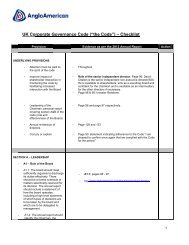GRI Indicator Table: Download pdf - Anglo American
GRI Indicator Table: Download pdf - Anglo American
GRI Indicator Table: Download pdf - Anglo American
Create successful ePaper yourself
Turn your PDF publications into a flip-book with our unique Google optimized e-Paper software.
<strong>GRI</strong> REPORTING SCORECARDFullycoveredPartiallycoveredNot reported/Not materialNot reported/Not availableThis table sets out how the Global Reporting (<strong>GRI</strong>) Reporting Framework has been applied across our Annual Report,Sustainability Development Report and website. We have prepared the table to help you navigate to the informationyou want quickly. Simply click on a cross-reference to view the page.The <strong>GRI</strong> Reporting Framework forms a key part of our commitment to economic, environmental and social sustainabilityand achieving the highest level of performance and most transparent level of reporting. Assured by PricewaterhouseCoopers,we have applied the <strong>GRI</strong> Framework to the highest A+ standard.For further information on the <strong>GRI</strong>, please visit https://www.globalreporting.org/Pages/default.aspxG3.1 Content Index – Mining & Metals Sector SupplementApplication Level A+Self-declaredAssured by PricewaterhouseCoopersSTANDARD DISCLOSURES PART I: Profile Disclosures1. Strategy and analysisProfileDisclosure Description Reported Cross-reference/Direct answerIf applicable, indicatethe part not reportedReason foromissionExplanation1.1 Statement from the most senior decision-maker of the organisation. SDR page 02-051.2 Description of key impacts, risks, and opportunities. SDR page 12-131 of 26
<strong>GRI</strong> REPORTING SCORECARDFullycoveredPartiallycoveredNot reported/Not materialNot reported/Not availableSTANDARD DISCLOSURES PART I: Profile Disclosures – continued2. Organisational profileProfileDisclosure Description Reported Cross-reference/Direct answerIf applicable, indicatethe part not reportedReason foromissionExplanation2.1 Name of the organisation. SDR front cover2.2 Primary brands, products, and/or services. www.angloamerican.com/business2.3 Operational structure of the organisation, including main divisions,operating companies, subsidiaries, and joint ventures.www.angloamerican.com/business2.4 Location of organisation's headquarters. www.angloamerican.com/siteservices/contactus/corp_officedetails2.5 Number of countries where the organisation operates, and namesof countries with either major operations or that are specifically relevantto the sustainability issues covered in the report.www.angloamerican.com/about/operate2.6 Nature of ownership and legal form. <strong>Anglo</strong> <strong>American</strong> is a publicly held and traded company.2.7 Markets served (including geographic breakdown, sectors served,and types of customers/beneficiaries).AR page 1 (inside cover) and pagesIron Ore: AR page 55Met Coal: AR page 61Thermal Coal: AR page 65Copper: AR page 69Nickel: AR page 73Platinum: AR page 77Diamonds: AR page 83OMI: AR page 872.8 Scale of the reporting organisation. www.angloamerican.com/about/operate2.9 Significant changes during the reporting period regarding size,structure, or ownership.SDR page 772.10 Awards received in the reporting period. www.angloamerican.com/development/ourperformance/awards-and-recognition/environment2 of 26
<strong>GRI</strong> REPORTING SCORECARDFullycoveredPartiallycoveredNot reported/Not materialNot reported/Not availableSTANDARD DISCLOSURES PART I: Profile Disclosures – continued3. Report ParametersProfileDisclosure Description Reported Cross-reference/Direct answer3.1 Reporting period (e.g., fiscal/calendar year) for information provided. 01 January 2012-31 December 2012If applicable, indicatethe part not reportedReason foromissionExplanation3.2 Date of most recent previous report (if any). 01 January 2011-31 December 20113.3 Reporting cycle (annual, biennial, etc.) Annual3.4 Contact point for questions regarding the report or its contents. Hermien Botes: hermien.botes@angloamerican.com3.5 Process for defining report content. <strong>Anglo</strong> <strong>American</strong> has applied the <strong>GRI</strong> guidance andprinciples on defining report content. See SDR pages12-13. Sustainability context is discussed on SDR page10. 100% of material issues as determined on pages12-13 for managed operations are reported on in fulland in a timely manner (monthly or quarterly internallyand annually externally).3.6 Boundary of the report (e.g., countries, divisions, subsidiaries,leased facilities, joint ventures, suppliers). See <strong>GRI</strong> Boundary Protocolfor further guidance.3.7 State any specific limitations on the scope or boundary of the report(see completeness principle for explanation of scope).3.8 Basis for reporting on joint ventures, subsidiaries, leased facilities,outsourced operations, and other entities that can significantly affectcomparability from period to period and/or between organisations.3.9 Data measurement techniques and the bases of calculations, includingassumptions and techniques underlying estimations applied to thecompilation of the <strong>Indicator</strong>s and other information in the report. Explainany decisions not to apply, or to substantially diverge from, the <strong>GRI</strong><strong>Indicator</strong> Protocols.3.10 Explanation of the effect of any re-statements of information providedin earlier reports, and the reasons for such re-statement (e.g.,mergers/acquisitions, change of base years/periods, nature of business,measurement methods).SDR page 01None to reportSDR page 01SDR page 78SDR pages 753.11 Significant changes from previous reporting periods in the scope,boundary, or measurement methods applied in the report.SDR pages 74,78 (exclusion of sponcomfrom CO2 emissions)3.12 <strong>Table</strong> identifying the location of the Standard Disclosures in the report. www.angloamerican.com/development/reports/aareports/2013gr3.13 Policy and current practice with regard to seeking external assurancefor the report.SDR pages 68-693 of 26
<strong>GRI</strong> REPORTING SCORECARDFullycoveredPartiallycoveredNot reported/Not materialNot reported/Not availableSTANDARD DISCLOSURES PART I: Profile Disclosures – continued4. Governance, Commitments, and EngagementProfileDisclosure Description Reported Cross-reference/Direct answer4.1 Governance structure of the organisation, including committees underAR 90-134the highest governance body responsible for specific tasks, such as settingstrategy or organisational oversight.4.2 Indicate whether the Chair of the highest governance body is also anexecutive officer.4.3 For organisations that have a unitary board structure, state the numberand gender of members of the highest governance body that areindependent and/or non-executive members.4.4 Mechanisms for shareholders and employees to providerecommendations or direction to the highest governance body.4.5 Linkage between compensation for members of the highest governancebody, senior managers, and executives (including departurearrangements), and the organisation's performance (including socialand environmental performance).4.6 Processes in place for the highest governance body to ensure conflictsof interest are avoided.4.7 Process for determining the composition, qualifications, and expertiseof the members of the highest governance body and its committees,including any consideration of gender and other indicators of diversity.4.8 Internally developed statements of mission or values, codes ofconduct, and principles relevant to economic, environmental, andsocial performance and the status of their implementation.4.9 Procedures of the highest governance body for overseeingthe organisation's identification and management of economic,environmental, and social performance, including relevant risksand opportunities, and adherence or compliance with internationallyagreed standards, codes of conduct, and principles.4.10 Processes for evaluating the highest governance body's ownperformance, particularly with respect to economic, environmental,and social performance.NoAR 92-93SDR page 15; AR pages 98-99. Employees are engagedvia regular briefing sessions with the CEO and otherexecutives, during which they are encouraged toprovide input/raise issues/concerns. In addition,employee surveys are conducted periodically.Feedback on material issues is given to the Board.Safety targets form part of all executive remuneration.Energy, water and CO2 targets are included in all BUCEO performance contracts. General informationavailable in AR pages 108-127AR 97AR 102-103. Expertise and skills regardingsustainability are considered in NomCo decisions,given that these issues are crucial to the Board'sresponsibility, in particular the role of the Board S&SDCommittee.SDR pages 18-21www.angloamerican.com/development/approachand-policiesSDR pages 18-21AR 96; We describe our process for evaluating Boardperformance on AR page 96, which included theperformance of the Board S&SD committee.If applicable, indicatethe part not reportedReason foromissionExplanation4 of 26
<strong>GRI</strong> REPORTING SCORECARDFullycoveredPartiallycoveredNot reported/Not materialNot reported/Not availableSTANDARD DISCLOSURES PART I: Profile Disclosures – continued4. Governance, Commitments, and Engagement – continuedProfileDisclosure Description Reported Cross-reference/Direct answerIf applicable, indicatethe part not reportedReason foromissionExplanation4.11 Explanation of whether and how the precautionary approach or principleis addressed by the organisation.In line with <strong>Anglo</strong> <strong>American</strong>’s commitment to theprinciples of the Global Compact and the variousinternal policies and procedures (including TheEnvironmental Way and SEAT), the principles thatunderlie the precautionary approach always takeprecedence, notably in our activities relating tomanagement of occupational safety and health, andour impacts on the environment. Examples of howwe implement these principles in our activities areraised in various sections of our SDR (pages 54-67).4.12 Externally developed economic, environmental, and social charters,principles, or other initiatives to which the organisation subscribesor endorses.SDR pages02-03; 17; 774.13 Memberships in associations (such as industry associations) and/ornational/international advocacy organisations in which the organisation: *Has positions in governance bodies; * Participates in projects orcommittees; * Provides substantive funding beyond routine membershipdues; or * Views membership as strategic.SDR pages 15-19, 22-23, 54-674.14 List of stakeholder groups engaged by the organisation. SDR page 14-164.15 Basis for identification and selection of stakeholders with whom to engage. SDR page 254.16 Approaches to stakeholder engagement, including frequency ofengagement by type and by stakeholder group.4.17 Key topics and concerns that have been raised through stakeholderengagement, and how the organisation has responded to those keytopics and concerns, including through its reporting.SDR pages 14-17, 29SDR pages 14-17, 295 of 26
<strong>GRI</strong> REPORTING SCORECARDFullycoveredPartiallycoveredNot reported/Not materialNot reported/Not availableSTANDARD DISCLOSURES PART II: Disclosures on Management Approach (DMAs)DMA ECDisclosure on Management Approach ECG3.1 MMSSDMAs Description Reported Cross-reference/Direct answerIf applicable, indicatethe part not reportedReason foromissionExplanationAspects Economic performance SDR pages 26-31 and AR 42-47Market presenceSDR inside cover, pages 26-35, 40-43. We are,according to our Human Resources Principlesand Business Principles, committed to providingcompetitive and fair wages and believe that we doso at all our operations. Entry level wages are alwaysequal to, or above local minimum wage in value.Indirect economic impacts SDR pages 24-26, 29-356 of 26
<strong>GRI</strong> REPORTING SCORECARDFullycoveredPartiallycoveredNot reported/Not materialNot reported/Not availableSTANDARD DISCLOSURES PART II: Disclosures on Management Approach (DMAs) – continuedDMA ENDisclosure on Management Approach ENG3.1 MMSSDMAs Description Reported Cross-reference/Direct answerAspects Materials <strong>Anglo</strong> <strong>American</strong> most significant input materials arefossil fuels (page 62) and water (page 58). Othermaterials used by weight or volume are not recordedon a Group level owing to the diverse processes usedthroughout <strong>Anglo</strong> <strong>American</strong> operations, business unitsdo report these individually. Please also see SDR pages66-67. <strong>Anglo</strong> <strong>American</strong>’s drive to reduce materialsconsumption is managed through the Group assetoptimisation (AO) drive. A central AO function runsmajor, Group-wide projects with broad application,while every mine investigates and implements localopportunities. Goal and performance indicators relateto financial value realised, though environmentalbenefits (like water and energy savings) are alsoreported separately.Energy SDR page 60-63If applicable, indicatethe part not reportedReason foromissionExplanationWater SDR pages 56-59Biodiversity SDR pages 64-65Emissions, effluents and wasteCOMM SDR pages 66-67Products and services SDR pages 66-67ComplianceTransportOverallSDR page 18-21. <strong>Anglo</strong> <strong>American</strong> Group companiesensure that their products are compliant withappropriate regulations: all EU bound products arenow registered with the European Chemicals Agency(ECHA). In addition, in collaboration with the metalsconsortia, our ores and concentrates have beenclassified according to the EU’s classification,Labelling and Packaging (CLP) regulation.<strong>Anglo</strong> <strong>American</strong>'s most material transportation issueis ocean freight. Our commitment in this regard is inthe context of Scope 3 GHG emissions, where we willseek to "understand and respond to the carbonlife-cycle risks and opportunities of our products."www.angloamerican.com/development/envsPolicies:www.angloamerican.com/development/approachand-policies/policies-standards-commitments/environment7 of 26
<strong>GRI</strong> REPORTING SCORECARDFullycoveredPartiallycoveredNot reported/Not materialNot reported/Not availableSTANDARD DISCLOSURES PART II: Disclosures on Management Approach (DMAs) – continuedDMA LADisclosure on Management Approach LAG3.1 MMSSDMAs Description Reported Cross-reference/Direct answerIf applicable, indicatethe part not reportedReason foromissionExplanationAspects EmploymentCOMM SDR pages 38-43Labour/management relationsCOMM SDR page 42Occupational health and safetyCOMM SDR pages 44-51Training and education SDR pages 40-41Diversity and equal opportunity SDR pages 41-42Equal remuneration for women and men<strong>Anglo</strong> <strong>American</strong>’s Business Principles andHuman Resources Principles are based on equalopportunity and non-discrimination, there is nodifference between male and female employeesalaries. All remuneration is calculated accordingto a single banding framework, which does not takeinto account gender, race or age. The framework isbased on pre-defined role descriptions.8 of 26
<strong>GRI</strong> REPORTING SCORECARDFullycoveredPartiallycoveredNot reported/Not materialNot reported/Not availableSTANDARD DISCLOSURES PART II: Disclosures on Management Approach (DMAs) – continuedDMA HRDisclosure on Management Approach HRG3.1 MMSSDMAs Description Reported Cross-reference/Direct answerAspects Investment and procurement practices SDR pages 32-35.Rigorous guidelines are appliedto the evaluation and execution of all acquisitionsthat require the approval of the Investment Committeeand Group Management Committee and, subject tosize, the Board.Non-discriminationFreedom of association and collective bargainingChild labourPrevention of forced and compulsory labour SDR page 42SDR page 42 Policieswww.angloamerican.com/~/media/Files/A/<strong>Anglo</strong>-<strong>American</strong>-Plc/siteware/docs/citizenship_bus_principles.<strong>pdf</strong>SDR page 42 Policieswww.angloamerican.com/~/media/Files/A/<strong>Anglo</strong>-<strong>American</strong>-Plc/siteware/docs/citizenship_bus_principles.<strong>pdf</strong>SDR page 42 Policieswww.angloamerican.com/~/media/Files/A/<strong>Anglo</strong>-<strong>American</strong>-Plc/siteware/docs/citizenship_bus_principles.<strong>pdf</strong>If applicable, indicatethe part not reportedReason foromissionExplanationSecurity practices SDR page 32<strong>Anglo</strong> <strong>American</strong> supports and follows the VoluntaryPrinciples on Security and Human RightsIndigenous rightsCOMMAssessment SDR page 33Online:www.angloamerican.com/development/social/community-engagement/indigenous-peoplesRemediation SDR pages 32-339 of 26
<strong>GRI</strong> REPORTING SCORECARDFullycoveredPartiallycoveredNot reported/Not materialNot reported/Not availableSTANDARD DISCLOSURES PART II: Disclosures on Management Approach (DMAs) – continuedDMA SODisclosure on Management Approach SOG3.1 MMSSDMAs Description Reported Cross-reference/Direct answerIf applicable, indicatethe part not reportedReason foromissionExplanationAspects Local communities SDR page 24Artisanal and small-scale miningNo material artisinal mining. Our SEAT process wouldensure that we assess operations and their zones ofinfluence to identify artisinal and small-scale miningand any associated risks. These would be managed inline with The <strong>Anglo</strong> <strong>American</strong> Social Way Performancestandards, local legal requirements and with the aid ofrelevant SEAT tools.ResettlementOnline:www.angloamerican.com/development/approachand-policies/human-rights/resettlementsClosure planningCOMM SDR page 21Grievance mechanisms and procedures SDR pages 32-33Emergency PreparednessCOMM<strong>Anglo</strong> <strong>American</strong>’s environment, health and safetystandards contain requirements relating to emergencypreparedness and response. They are that eachoperation is required to establish, implement andmaintain a procedure(s) to identify potentialemergency situations and potential accidents that canhave an impact(s) on the environment and how it willrespond to them. It is also a requirement that theyrespond to actual emergency situations and accidentsand prevent or mitigate associated adverseenvironmental impacts; and periodically test relatedprocedures, where practicable.Corruption100% All operations; risks including corruption risks,are reviewed every year. SDR page 18-20Public policy SDR page 16Anti-competitive behaviour AR page 52ComplianceAll <strong>Anglo</strong> <strong>American</strong> policies and business principlesare, in the first instance, concerned with legalcompliance. For more information go to:www.angloamerican.com/development/approachand-policies/policies-standards-commitments/environment10 of 26
<strong>GRI</strong> REPORTING SCORECARDFullycoveredPartiallycoveredNot reported/Not materialNot reported/Not availableSTANDARD DISCLOSURES PART II: Disclosures on Management Approach (DMAs) – continuedDMA PRDisclosure on Management Approach PRG3.1 MMSSDMAs Description Reported Cross-reference/Direct answerAspects Materials stewardship Online:www.angloamerican.com/development/envs/materials-stewardshipIf applicable, indicatethe part not reportedCustomer health and safety Not material All Not material <strong>Anglo</strong> <strong>American</strong> does not deal directly with consumersbut sells on commodity markets and to a small numberof industrial users.Product and service labelling Not material All Not material <strong>Anglo</strong> <strong>American</strong>’s ‘products’ are rawmaterials typically used as inputs into furthermanufacturing processes. Packaging is not applicable tobulk product transport by railand bulk shipping.Marketing communications Not material All Not material Marketing communications is not applicable as <strong>Anglo</strong><strong>American</strong> is not directly involved in consumeradvertising, and does not deal directly with consumersbut sells on commodity markets and to a small numberof industrial users.Customer privacy Not material All Not material Customer privacy is not applicable as<strong>Anglo</strong> <strong>American</strong> is not directly involved in consumeradvertising, and does not deal directly with consumersbut sells on commodity markets and to a small numberof industrial users.Compliance SDR pages 18-21<strong>Anglo</strong> <strong>American</strong> Group companies ensure that theirproducts are compliant with appropriate regulations:all EU-bound products are now registered with theEuropean Chemicals Agency (ECHA). In addition,in collaboration with the metals consortia, our oresand concentrates have been classified accordingto the EU’s classification, Labelling and Packaging(CLP) regulation.Reason foromissionExplanation11 of 26
<strong>GRI</strong> REPORTING SCORECARDFullycoveredPartiallycoveredNot reported/Not materialNot reported/Not availableSTANDARD DISCLOSURES PART III: Performance <strong>Indicator</strong>sEconomicPerformance<strong>Indicator</strong> Description Reported Cross-reference/Direct answerIf applicable, indicatethe part not reportedReason foromissionExplanationEconomic performanceEC1COMMDirect economic value generated and distributed, including revenues,operating costs, employee compensation, donations and othercommunity investments, retained earnings, and payments to capitalproviders and governments.SDR pages 26-31EC2Financial implications and other risks and opportunities forthe organisation's activities due to climate change.SDR pages 02-05, 54, 60-63EC3 Coverage of the organisation's defined benefit plan obligations. AR 144EC4 Significant financial assistance received from government. None receivedMarket presenceEC6EC7COMMEC8EC9Policy, practices, and proportion of spending on locally-based suppliersat significant locations of operation.Procedures for local hiring and proportion of senior managementand workforce hired from the local community at significant locationsof operation.Indirect economic impactsDevelopment and impact of infrastructure investments and servicesprovided primarily for public benefit through commercial, in-kind, orpro bono engagement.Understanding and describing significant indirect economic impacts,including the extent of impacts.SDR pages 33-35, Local is defined as nationaland localised is defined as 'close to the operation'.Factors that influence supplier selection includetheir social and environmental performance.SDR pages 40-41, at all our operations our practicesfavour employing locally, including hiring for seniormanagement positions (approximate Pattersonbands 1-5). More than 95% of permanent employeesare from host countries and more than 95% of seniormanagement at corporate centres is from hostcountries (with the exception of the London office).As some <strong>Anglo</strong> <strong>American</strong> operations are situatedin very remote locations with no, or small, localcommunities, most business units have policiesand procedures relating to local hiring in place, inaddition to training programmes aimed at providinglliiihiildkilllocal communities with mining-related skills.SDR pages 24-25, 29-35. Needs analyses areconducted initially through Social and EnvironmentalImpact Assessments and every three years via the<strong>Anglo</strong> <strong>American</strong> Socio-Economic Assessment Toolbox.Results of assessments are published in operationalSEAT reports and specific to the operation's zoneof influence.SDR pages 26, 32-35.12 of 26
<strong>GRI</strong> REPORTING SCORECARDFullycoveredPartiallycoveredNot reported/Not materialNot reported/Not availableSTANDARD DISCLOSURES PART III: Performance <strong>Indicator</strong>s – continuedEnvironmentalPerformance<strong>Indicator</strong> Description Reported Cross-reference/Direct answerIf applicable, indicatethe part not reportedReason foromissionExplanationMaterialsEN1 Materials used by weight or volume. <strong>Anglo</strong> <strong>American</strong> most significant input materials interms of environmental impact and risk to the businessare fossil fuels (page 62) and water (page 58). Othermaterials, such as lime, explosives, tyres and greaseare not recorded at a Group level owing to the diverseprocesses used throughout <strong>Anglo</strong> <strong>American</strong>operations, business units do report these individually.EN2COMMPercentage of materials used that are recycled input materials. Not material All Not material <strong>Anglo</strong> <strong>American</strong> is a producer of primaryraw materials.EnergyEN3 Direct energy consumption by primary energy source. SDR page 62EN4 Indirect energy consumption by primary source. SDR pages 62-63EN5 Energy saved due to conservation and efficiency improvements. SDR page 62EN7 Initiatives to reduce indirect energy consumption and reductions achieved. SDR pages 60-63WaterEN8 Total water withdrawal by source. SDR page 58EN9 Water sources significantly affected by withdrawal of water. SDR page 58 Size of water source and if source isdesignated protected areaEN10 Percentage and total volume of water recycled and reused. SDR page 58Not availableThe biodiversity overlap assessment tool was developedin 2012 an will be used to develop global map of ouroperations and their greatest biodiversity risks.13 of 26
<strong>GRI</strong> REPORTING SCORECARDFullycoveredPartiallycoveredNot reported/Not materialNot reported/Not availableSTANDARD DISCLOSURES PART III: Performance <strong>Indicator</strong>s – continuedEnvironmental – continuedPerformance<strong>Indicator</strong> Description Reported Cross-reference/Direct answerIf applicable, indicatethe part not reportedReason foromissionExplanationBiodiversityEN11EN12COMMMM1EN13COMMEN14COMMMM2EN15Location and size of land owned, leased, managed in, or adjacent to,protected areas and areas of high biodiversity value outside protectedareas.Description of significant impacts of activities, products, and services onbiodiversity in protected areas and areas of high biodiversity value outsideprotected areas.Amount of land (owned or leased, and managed for production activities orextractive use) disturbed or rehabilitated.SDR page 65 Size of operational site Not available the biodiversity overlap assessment tool was developedin 2012 an will be used to develop global map of ouroperations and their greatest biodiversity risks.SDR pages 64-65SDR pages 64-65Habitats protected or restored. SDR pages 64-65 Restoration independently verified Not available In South Africa final verification must be given by thegovernment, which to date is outstandingStrategies, current actions, and future plans for managing impacts onbiodiversity.The number and percentage of total sites identified as requiringbiodiversity management plans according to stated criteria, and thenumber (percentage) of those sites with plans in place.Number of IUCN Red List species and national conservation list specieswith habitats in areas affected by operations, by level of extinction risk.SDR page 64-65 Target Not available The <strong>Anglo</strong> <strong>American</strong> land and biodiversity strategy isbeing reviewed in 2012/3 and will set relevant targetsSDR page 64-65SDR page 65Emissions, effluents and wasteEN16 Total direct and indirect greenhouse gas emissions by weight. SDR page 62EN17 Other relevant indirect greenhouse gas emissions by weight. SDR page 62EN18 Initiatives to reduce greenhouse gas emissions and reductions achieved. SDR page 62EN19 Emissions of ozone-depleting substances by weight. Not material All Not material Given the nature of <strong>Anglo</strong> <strong>American</strong>'s business,ozone-depleting substances are not a significantenvironmental impact of the companyEN20COMMNOx, SOx, and other significant air emissions by type and weight.The potential for impacts on ambient air qualityfrom our mining and processing activities resultsprimarily from particulate emissions (fine and coarsedust), sulphur dioxide (SO2), nitrogen oxides (NOx)and volatile organic compounds (VOCs). Coarse dustand SO2 are primarily local pollutants, with the mostsignificant impacts potentially occurring in closevicinity of the source. Air emissions (aside fromSO2 – see SDR page 67) are therefore reportedat a local level.SO2 is reported at a Group level, whileother localised pollutants are reportedon in business unit reports.Not availableIn 2013 we will begin to collect group wide data onSox and Nox associated with the combustion ofdiesel and explosives.14 of 26
<strong>GRI</strong> REPORTING SCORECARDFullycoveredPartiallycoveredNot reported/Not materialNot reported/Not availableSTANDARD DISCLOSURES PART III: Performance <strong>Indicator</strong>s – continuedEnvironmental – continuedPerformance<strong>Indicator</strong> Description Reported Cross-reference/Direct answerIf applicable, indicatethe part not reportedEN21 Total water discharge by quality and destination. SDR pages 58-59 Qualitative description at Group andBU level, some quantitative figures atBU level.EN22COMMMM3EN23COMMEN24EN25Total weight of waste by type and disposal method. SDR page 66-67 Qualitative description at Group andBU level, some quantitative figures atBU level.Total amounts of overburden, rock, tailings, and sludges and theirassociated risks.Total number and volume of significant spills.Weight of transported, imported, exported, or treated waste deemedhazardous under the terms of the Basel Convention Annex I, II, III, and VIII,and percentage of transported waste shipped internationally.Identity, size, protected status, and biodiversity value of water bodies andrelated habitats significantly affected by the reporting organisation'sdischarges of water and runoff.Products and servicesSDR page 66SDR page 67, ZeroSDR page 66, ZeroQualitative description at Group andBU level, some quantitative figures atBU level.Reason foromissionExplanationNot material All significant incidents are reported as level 1-5incidents. Reporting volumes and qualities of dischargesat a Group level provides no information on whether theyexceeded local volume or quality allowances.Not availableNot availableThe focus has been on effective waste management,which is highly regulated and well managed at a locallevel. During 2011 we included a number of new wasteparameters in our Group database, which will aidGroup-level reporting.The focus has been on effective waste management,which is highly regulated and well managed at a locallevel. During 2011 we included a number of new wasteparameters in our Group database, which will aidGroup-level reporting.SDR page 58 Size of water body Not available The biodiversity overlap assessment tool was developedin 2012 an will be used to develop global map of ouroperations and their greatest biodiversity risks.EN26EN27EN28Initiatives to mitigate environmental impacts of products and services, andextent of impact mitigation.Percentage of products sold and their packaging materials that arereclaimed by category.ComplianceMonetary value of significant fines and total number of non-monetarysanctions for non-compliance with environmental laws and regulations.Initiatives to mitigate the most significantenvironmental impact of products /service groups inrelation to materials use relates to water (pages 56-59)and GHG and direct energy (pages 60-63) reductioninitiatives; other initiatives are described on pages48-50 (noise); 66-67 (waste) and 58 (effluents).Quantitative information forinitiatives described.Not availableNot all figures are available at a Group level. Businessunits report on a risk-basisNot material All Not applicable <strong>Anglo</strong> <strong>American</strong> "products" are raw materials typicallyused as inputs into further manufacturing processes.Packaging is not applicable to bulk product transport byrail and bulk shipping.7 actions; USD $71 ,687.58 in legal costs15 of 26
<strong>GRI</strong> REPORTING SCORECARDFullycoveredPartiallycoveredNot reported/Not materialNot reported/Not availableSTANDARD DISCLOSURES PART III: Performance <strong>Indicator</strong>s – continuedEnvironmental – continuedPerformance<strong>Indicator</strong> Description Reported Cross-reference/Direct answerIf applicable, indicatethe part not reportedReason foromissionExplanationTransportEN29Significant environmental impacts of transporting products and othergoods and materials used for the organisation's operations, andtransporting members of the workforce.GHG emissions from ocean freight are <strong>Anglo</strong>Methodology for determining<strong>American</strong>’s most material environmental transportation environmental impact not reported.issue. Our current goal is to understand such scope 3emissions, after which formal reduction initiatives maybe pursued.Not availableA full environmental impact assessment on theimpact of ocean freight has not been conducted.OverallEN30 Total environmental protection expenditures and investments by type. SDR pages 58,60 and 65 Expenditure on materialenvironmental risks is reported(e.g. water and climate changeR&D). Expenditure related tolegal compliance and the everyday operational activities is notreported separately.Not availableEnvironmental expenditure is an integral part ofoperating costs and is not accounted for separately.Hence, this indicator is not considered to be usefulby the company.16 of 26
<strong>GRI</strong> REPORTING SCORECARDFullycoveredPartiallycoveredNot reported/Not materialNot reported/Not availableSTANDARD DISCLOSURES PART III: Performance <strong>Indicator</strong>s – continuedSocial: Labour Practices and Decent WorkPerformance<strong>Indicator</strong> Description Reported Cross-reference/Direct answerIf applicable, indicatethe part not reportedReason foromissionExplanationEmploymentLA1LA2LA3Total workforce by employment type, employment contract, and region,broken down by gender.Total number and rate of new employee hires and employee turnover byage group, gender, and region.Benefits provided to full-time employees that are not provided totemporary or part-time employees, by major operations.SDR page 40, 75SDR page 75Share options and pension schemes are examplesof benefits to full-time employeesHeadcount figures are currentlyreported according to employmentcontract, business unit and geography,but not according to employment typeand genderEmployee turnover numberscategorised by gender and region andageNot availableNot availableWe started recording this in 2011, but will only be able toreport in 2013The split is not a material management indicatorbecause of <strong>Anglo</strong> <strong>American</strong>’s policy of nondiscrimination.However, a group-wide headcountreporting project is now collecting these figures whichmay be available for reporting in 2013.LA15 Return to work and retention rates after parental leave, by gender. N/A All Not material There is no discrimination towards employees whotake parental leave, ensuring equal opportunity ontheir return to the workplace. Turnover rates are notcurrently linked with parental leave as this is not seenas being material.Labour/management relationsLA4 Percentage of employees covered by collective bargaining agreements. SDR page 42LA5Minimum notice period(s) regarding significant operational changes,including whether it is specified in collective agreements.<strong>Anglo</strong> America Platinum’s ERRA – a collectiveagreement that regulates the relationship between therecognised unions and the business – covers anyorganisational changes and how management consultson issues impacting on employees or their unions. Aminimum of one month’s notice is specified in theagreements.<strong>Anglo</strong> <strong>American</strong> currently only reportson this parameter at <strong>Anglo</strong> <strong>American</strong>Platinum.Not materialThe issue is not considered material for other businessunits to report. Throughout our operations, systems arein place aimed at ensuring effective dialogue andrelations with all employee representative groups.Notice periods vary significantly based on skills set andnational norms, and are generally specified in bothindividual and collective contractual agreements.MM4Number of strikes and lock-outs exceeding one week's duration, bycountry.SDR page 4217 of 26
<strong>GRI</strong> REPORTING SCORECARDFullycoveredPartiallycoveredNot reported/Not materialNot reported/Not availableSTANDARD DISCLOSURES PART III: Performance <strong>Indicator</strong>s – continuedSocial: Labour Practices and Decent Work – continuedPerformance<strong>Indicator</strong> Description Reported Cross-reference/Direct answerIf applicable, indicatethe part not reportedReason foromissionExplanationOccupational health and safetyLA6LA7COMMLA8Percentage of total workforce represented in formal joint managementworkerhealth and safety committees that help monitor and advise onoccupational health and safety programs.Rates of injury, occupational diseases, lost days, and absenteeism, andnumber of work-related fatalities by region and by gender.Education, training, counseling, prevention, and risk-control programs inplace to assist workforce members, their families, or community membersregarding serious diseases.In the mining industry in South Africa, which hosts 72%of our permanent workforce, in line with legislationrequiring that every mine with 20 or more employeesmust have a health and safety representative for eachshift at each designated working place at the mine,approximately 5% of the workforce is representedRemaining 28% of workforce; levelthe committee are represented on.Not materialThe most material health and safety concerns arein South Africa where the issue is legislated, althoughsimilar safety committees are in place in other operation.The level of these committees is not seen as amaterial risk.SDR pages 44-51, 70-71 Absenteeism rate Not available These figures are monitored and reported internally,but require further scrutnity for consistency andaccuracy before public reporting is possible,SDR pages 49-51LA9 Health and safety topics covered in formal agreements with trade unions. In South Africa, where 72% of our permanent workforceis located, this is either determined by law or negotiatedwith trade unions. Topics include the selection,appointment and dismissal or safety representativesand conditions relating to refusal to work.Training and educationLA10LA11LA12LA13Average hours of training per year per employee by gender, and byemployee category.Programs for skills management and lifelong learning that support thecontinued employability of employees and assist them in managing careerendings.Percentage of employees receiving regular performance and careerdevelopment reviews, by gender.Diversity and equal opportunityComposition of governance bodies and breakdown of employees peremployee category according to gender, age group, minority groupmembership, and other indicators of diversity.SDR pages 40-41SDR page 41Total training cost and training costs asa percentage of total employee costsreported. Training hours is not amanagement metric, although the HRreporting project will enable us toreport on training hours in the future.Not availableTotal training cost and training costs as a percentage oftotal employee costs reported. Training hours is not amanagement metric, although the HR reporting projectwill enable us to report on training hours in the future.SDR page 41 Quantitative measure Not available These figures were not recorded in 2012 because theytend to mirror management and non-managementlevels. They will be recorded again in 2013.SDR pages 41-42, AR 92-3 categorisation by age group Not applicable <strong>Anglo</strong> <strong>American</strong> does not discriminate on the basis ofage or any other characteristic that is arbitraty to theability to perform work duties. Gender and racialdiversity are material issues for <strong>Anglo</strong> <strong>American</strong>, inSouth Africa in particular, and these are reported oncomprehensively. Age is not a material issue.18 of 26
<strong>GRI</strong> REPORTING SCORECARDFullycoveredPartiallycoveredNot reported/Not materialNot reported/Not availableSTANDARD DISCLOSURES PART III: Performance <strong>Indicator</strong>s – continuedSocial: Labour Practices and Decent Work – continuedPerformance<strong>Indicator</strong> Description Reported Cross-reference/Direct answerIf applicable, indicatethe part not reportedReason foromissionExplanationEqual remuneration for women and menLA14Ratio of basic salary and remuneration of women to menby employee category, by significant locations of operation.None Ratio not reported Not material <strong>Anglo</strong> <strong>American</strong>'s Business Principles and HumanResources Principles are based on equal opportunityand non-discrimination, there is no difference betweenmale and female employee salaries. All remuneration iscalculated according to a single banding framework,which does not take into account gender, race or age.The framework is based on pre-defined roledescriptions.19 of 26
<strong>GRI</strong> REPORTING SCORECARDFullycoveredPartiallycoveredNot reported/Not materialNot reported/Not availableSTANDARD DISCLOSURES PART III: Performance <strong>Indicator</strong>s – continuedSocial: Human RightsPerformance<strong>Indicator</strong> Description Reported Cross-reference/Direct answerIf applicable, indicatethe part not reportedReason foromissionExplanationInvestment and procurement practicesHR1HR2HR3Percentage and total number of significant investment agreements andcontracts that include clauses incorporating human rights concerns, or thathave undergone human rights screening.Percentage of significant suppliers, contractors and other businesspartners that have undergone human rights screening, and actions taken.Total hours of employee training on policies and procedures concerningaspects of human rights that are relevant to operations, including thepercentage of employees trained.Non-discriminationSDR page 32SDR page 32SDR pages 26, 32HR4 Total number of incidents of discrimination and corrective actions taken. No significant instances of discrimination reported.SDR page 42Freedom of association and collective bargainingHR5COMMHR6Operations and significant suppliers identified in which the right to exercisefreedom of association and collective bargaining may be violated or atsignificant risk, and actions taken to support these rights.Child labourOperations and significant suppliers identified as having significant risk forincidents of child labour, and measures taken to contribute to the effectiveabolition of child labour.SDR pages 32, 42Significant suppliers are those that have been identifiedas high-risk from an SD perspective due to factors suchas their industry or location. <strong>Anglo</strong> <strong>American</strong>'s BusinessPrinciples actively support the right to collectivebargaining and freedom of association - these applythoughout our business and our supply chain.SDR pages 32, 42<strong>Anglo</strong> <strong>American</strong> operations have formal procedures toverify, among other things, the age of employees.Significant suppliers are those that have been identifiedas high-risk from an SD perspective due to factors suchas their industry or location. <strong>Anglo</strong> <strong>American</strong>'s businessprinciples advance the abolition of child labour andthese apply throughout our business and supply chain.20 of 26
<strong>GRI</strong> REPORTING SCORECARDFullycoveredPartiallycoveredNot reported/Not materialNot reported/Not availableSTANDARD DISCLOSURES PART III: Performance <strong>Indicator</strong>s – continuedSocial: Human Rights – continuedPerformance<strong>Indicator</strong> Description Reported Cross-reference/Direct answerIf applicable, indicatethe part not reportedReason foromissionExplanationPrevention of forced and compulsory labourHR7HR8MM5HR9Operations and significant suppliers identified as having significant risk forincidents of forced or compulsory labour, and measures to contribute tothe elimination of all forms of forced or compulsory labour.Security practicesPercentage of security personnel trained in the organisation's policies orprocedures concerning aspects of human rights that are relevant tooperations.Indigenous rightsTotal number of operations taking place in or adjacent to IndigenousPeoples' territories, and number and percentage of operations or siteswhere there are formal agreements with Indigenous Peoples'communities.Total number of incidents of violations involving rights of indigenouspeople and actions taken.SDR page 32No significant incidents of forced/compulsory laboutwas found in our 2012 supplier audits. Measures tocontribute to the elimination of forced/compulsorylabour include the human rights requirements in ourSupplier Sustainable Development Code and relatedsupplier audits. (We broadly define significant as anissue that can materially impact on the Group or aGroup business’ profitability and/or reputation or thathas the ability to materially influence decisions made bykey stakeholders concerning the Company.)SDR page 32All of our Australian operations take place in oradjacent to Indigenous People's Territories. Each of ourQueensland operations (Moranbah North, Grosvenor,Capcoal, Foxleigh, Dawson and Callide) has formalAboriginal cultural heritage agreements with their localIndigenous groups. In addition, Moranbah North,Grosvenor and Callide have previously executed nativetitle agreements with their local Indigenous groups forthe grant of mining leases or subsidiary approvals overland subject to native title. Neither of our New SouthWales operations/projects (Drayton/Dartbrook) hasagreements regarding Aboriginal cultural heritage, as itis dealt with under a government permit system in thatstate. Neither Drayton nor Dartbrook has required anynative title agreements.SDR pages 32-3321 of 26
<strong>GRI</strong> REPORTING SCORECARDFullycoveredPartiallycoveredNot reported/Not materialNot reported/Not availableSTANDARD DISCLOSURES PART III: Performance <strong>Indicator</strong>s – continuedSocial: Human Rights – continuedPerformance<strong>Indicator</strong> Description Reported Cross-reference/Direct answerIf applicable, indicatethe part not reportedReason foromissionExplanationAssessmentHR10HR11Percentage and total number of operations that have beensubject to human rights reviews and/or impact assessments.Remediation“Number of grievances related to human rights filed, addressedand resolved through formal grievance mechanisms.”All operations have SEAT reports in place. Theseinclude human right simpact assessment requirements.SDR pages 32-33 Categorisation of grievances Not material Detail on the in-depth categorisation of grievancesis reported internally but not material enough toreport externally as the issues raised were notconsidered material.22 of 26
<strong>GRI</strong> REPORTING SCORECARDFullycoveredPartiallycoveredNot reported/Not materialNot reported/Not availableSTANDARD DISCLOSURES PART III: Performance <strong>Indicator</strong>s – continuedSocial: SocietyPerformance<strong>Indicator</strong> Description Reported Cross-reference/Direct answerIf applicable, indicatethe part not reportedReason foromissionExplanationLocal communitiesSO1COMM(MMSS)SO1(G3.1)MM6MM7MM8MM8MM9Nature, scope, and effectiveness of any programs and practices thatassess and manage the impacts of operations on communities, includingentering, operating, and exiting.Percentage of operations with implemented local communityengagement, impact assessments, and development programs.Number and description of significant disputes relating to land use,customary rights of local communities and Indigenous Peoples.The extent to which grievance mechanisms were used to resolve disputesrelating to land use, customary rights of local communities and IndigenousPeoples, and the outcomes.Artisanal and small-scale miningNumber (and percentage) or company operating sites where artisanaland small-scale mining (ASM) takes place on, or adjacent to, the site; theassociated risks and the actions taken to manage and mitigate these risks.Artisanal and small-scale miningNumber (and percentage) or company operating sites where artisanaland small-scale mining (ASM) takes place on, or adjacent to, the site; theassociated risks and the actions taken to manage and mitigate these risks.ResettlementSites where resettlements took place, the number of households resettledin each, and how their livelihoods were affected in the process.Closure planningSDR page 24SDR page 24SDR pages 32-33 Nature and description of disputes Not material None of the issues raised were material at a Grouplevel and were therefore only reported on in anaggregated manner.SDR pages 32-33No artisinal mining poses a significant riskto <strong>Anglo</strong> <strong>American</strong> operations.No artisinal mining poses a significant riskto <strong>Anglo</strong> <strong>American</strong> operations.www.angloamerican.com/development/approachand-policies/human-rights/resettlementsMM10 Number and percentage of operations with closure plans. SDR page 21 (52/52 have close plans in place).Financial information provisions can be foundin the SDR page 65.SO9SO10Operations with significant potential or actual negative impactson local communities.Prevention and mitigation measures implemented in operations withsignificant potential or actual negative impacts on local communities.All operations have the potential to impacton local communitiesSDR pages 24-35; 5123 of 26
<strong>GRI</strong> REPORTING SCORECARDFullycoveredPartiallycoveredNot reported/Not materialNot reported/Not availableSTANDARD DISCLOSURES PART III: Performance <strong>Indicator</strong>s – continuedSocial: Society – continuedPerformance<strong>Indicator</strong> Description Reported Cross-reference/Direct answerIf applicable, indicatethe part not reportedReason foromissionExplanationCorruptionSO2Percentage and total number of business units analyzed for risks relatedto corruption.100% All operations; risks including corruption risks,are reviewed every year.SO3Percentage of employees trained in organisation's anti-corruptionpolicies and procedures.SDR pages 20-21SO4 Actions taken in response to incidents of corruption. SDR page 20Public policySO5SO6SO7SO8COMMPublic policy positions and participation in public policy developmentand lobbying.Total value of financial and in-kind contributions to political parties,politicians, and related institutions by country.Anti-competitive behaviorTotal number of legal actions for anti-competitive behavior, anti-trust,and monopoly practices and their outcomes.ComplianceMonetary value of significant fines and total number of non-monetarysanctions for non-compliance with laws and regulations.SDR page 16SDR page 16None169 sanctions; USD $1 385 250.21 in legal costs24 of 26
<strong>GRI</strong> REPORTING SCORECARDFullycoveredPartiallycoveredNot reported/Not materialNot reported/Not availableSTANDARD DISCLOSURES PART III: Performance <strong>Indicator</strong>s – continuedSocial: Product ResponsibilityPerformance<strong>Indicator</strong> Description Reported Cross-reference/Direct answerIf applicable, indicatethe part not reportedReason foromissionExplanationMaterials StewardshipMM11 Programs and progress relating to materials stewardship. SDR pages 60-61, 66Customer health and safetyPR1Life cycle stages in which health and safety impacts of products andservices are assessed for improvement, and percentage of significantproducts and services categories subject to such procedures.Much of our life cycle analysis takes place with regardto materials use related to water (pages 58-59) andGHG emissions (pages 62-63). We also conductassessment as part of compliance requirements forREACH (page 66).Marketing and promotion Not applicable Our most material compliance issue has related toREACH. A gap analysis will determine whetheradditional reporting is required.PR2Total number of incidents of non-compliance with regulations andvoluntary codes concerning health and safety impacts of products andservices during their life cycle, by type of outcomes.None to reportProduct and service labellingPR3PR4PR5Type of product and service information required by procedures, andpercentage of significant products and services subject to suchinformation requirements.Total number of incidents of non-compliance with regulations andvoluntary codes concerning product and service information and labeling,by type of outcomes.Practices related to customer satisfaction, including results of surveysmeasuring customer satisfaction.<strong>Anglo</strong> <strong>American</strong> Group companies ensure that all theirrelevant products (commodities) are compliant withappropriate regulations. All EU-bound products subjectto the REACH process with regard to their safe use arenow registered with the European Chemicals Agency(ECHA). In addition, in collaboration with the metalsconsortia, our ores and concentrates have beenclassified according to the EU’s Classification, Labellingand Packaging (CLP) regulation. Mineral SafetyDevelopment Sheets are provided with all our miningproducts and directed at industrial users. None of ourproducts are delivered directly to consumers. Thesourcing of components is not material. The content ofproducts with regard to substances that might producean environmental or social impact is not applicable forcommodities. Safe use of our commodities is notapplicable; disposal of our product and environmental/social impacts is not applicable because commoditiesare typically input materialNone to reportN/A All Not material This parameter is not regarded as material to <strong>Anglo</strong><strong>American</strong> as the Group does not deal directly withconsumers but sells on commodity markets and to asmall number of industrial users with whom there is adirect relationship and therefore direct feedback.25 of 26
<strong>GRI</strong> REPORTING SCORECARDFullycoveredPartiallycoveredNot reported/Not materialNot reported/Not availableSTANDARD DISCLOSURES PART III: Performance <strong>Indicator</strong>s – continuedSocial: Product Responsibility – continuedPerformance<strong>Indicator</strong> Description Reported Cross-reference/Direct answerIf applicable, indicatethe part not reportedReason foromissionExplanationMarketing communicationsPR6PR7PR8PR9Programs for adherence to laws, standards, and voluntary codesrelated to marketing communications, including advertising, promotion,and sponsorship.Total number of incidents of non-compliance with regulations andvoluntary codes concerning marketing communications, includingadvertising, promotion, and sponsorship by type of outcomes.Customer privacyTotal number of substantiated complaints regarding breaches ofcustomer privacy and losses of customer data.ComplianceMonetary value of significant fines for non-compliance with laws andregulations concerning the provision and use of products and services.N/A All Not material This parameter is not regarded as applicable to<strong>Anglo</strong> <strong>American</strong> as <strong>Anglo</strong> <strong>American</strong> is not directlyinvolved in consumer advertising.None to reportNone to reportNone to report26 of 26



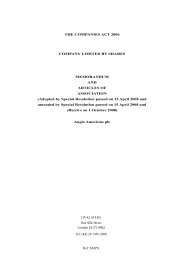
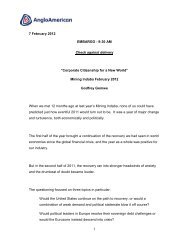
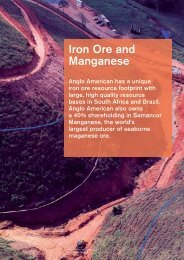
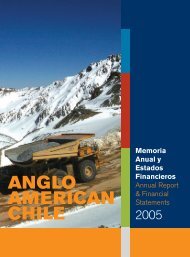
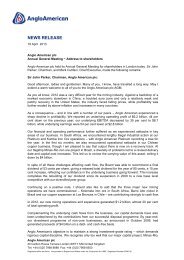
![English PDF [ 189KB ] - Anglo American](https://img.yumpu.com/50470814/1/184x260/english-pdf-189kb-anglo-american.jpg?quality=85)
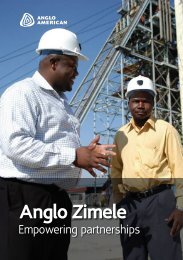

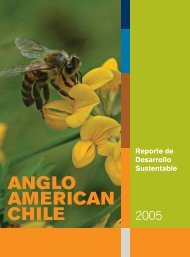

![pdf [ 595KB ] - Anglo American](https://img.yumpu.com/49420483/1/184x260/pdf-595kb-anglo-american.jpg?quality=85)
![pdf [ 1.1MB ] - Anglo American](https://img.yumpu.com/49057963/1/190x240/pdf-11mb-anglo-american.jpg?quality=85)
